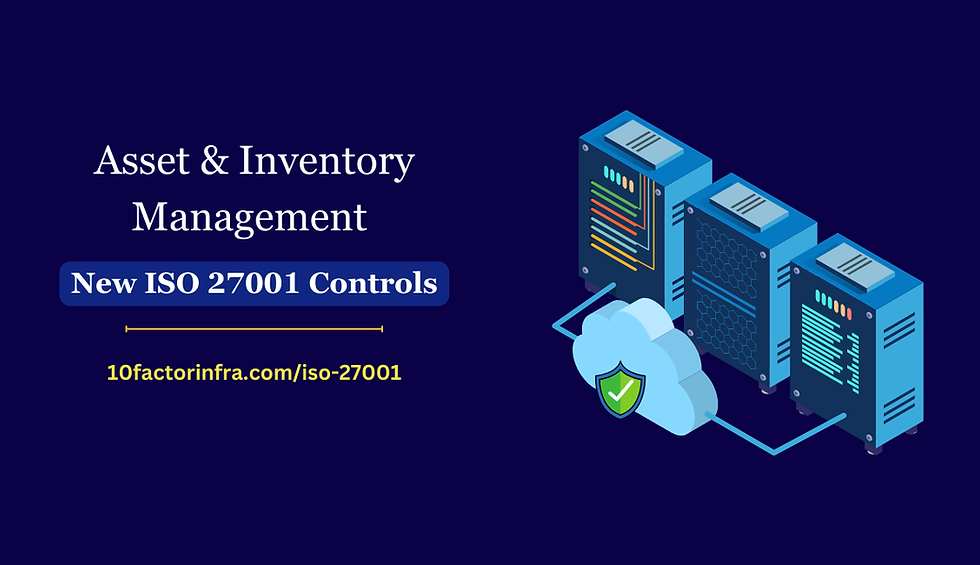Asset & Inventory Management in ISO 27001 Controls
- Kamalika Majumder | DevOps & ISO 27001 Consultant

- 4 days ago
- 4 min read

Asset and inventory management is a crucial component of information security, ensuring that organisations maintain visibility and control over their information assets. ISO 27001:2022, the latest iteration of the globally recognised standard for information security management systems (ISMS), places significant emphasis on asset management.
Organisations that fail to maintain a comprehensive asset inventory risk exposing their critical information to unauthorised access, loss, or misuse. This article explores the role of asset and inventory management in ISO 27001:2022 and how organisations can effectively implement these controls.
Understanding Asset & Inventory Management in ISO 27001:2022
Asset and inventory management refers to the processes involved in identifying, classifying, and managing an organisation's information assets. Assets include hardware, software, databases, documentation, and intellectual property.
ISO 27001:2022 specifically introduces controls related to asset management, aligning with modern security threats and digital transformation trends.
ISO 27001:2022 introduces the following key asset management-related controls:
5.9 Inventory of Information and Other Associated Assets – Requires organisations to maintain an up-to-date inventory of information assets and associated resources.
5.10 Acceptable Use of Information and Other Associated Assets – Establishes policies on how assets should be used securely and responsibly.
5.11 Return of Assets – Ensures that assets are returned when an employee or third party leaves or no longer requires access.
8.3 Information access restriction – Access to information and other associated assets shall be restricted in accordance with the established topic-specific policy on access control.
7.9 Security of assets off-premises – Off-site assets shall be protected.
7.1 Physical security perimeters – Security perimeters shall be defined and used to protect areas that contain information and other associated assets.
These controls reinforce the need for a structured approach to tracking, classifying, and safeguarding organisational assets, thereby reducing security risks and ensuring compliance.
Importance of Asset & Inventory Management in ISO 27001:2022
1. Visibility and Accountability:
One of the primary advantages of asset and inventory management is the ability to track and monitor assets in real-time. A well-maintained inventory ensures that each asset is assigned to an owner, improving accountability and reducing the risk of unauthorised access.
2. Risk Management and Threat Mitigation
Identifying and classifying assets enables organisations to assess potential risks. By knowing which assets hold sensitive data, organisations can implement appropriate security measures such as encryption, access controls, and monitoring. This proactive approach helps mitigate threats such as data breaches and insider threats.
3. Compliance with Regulatory Requirements
Many regulatory frameworks, including ISO 27001:2022, require organisations to maintain an accurate inventory of information assets. Effective asset management not only aids in compliance with ISO 27001 but also supports adherence to GDPR, PCI DSS, and other industry regulations.
4. Enhanced Incident Response and Recovery
In the event of a security incident, a well-documented asset inventory allows organisations to quickly identify affected assets and implement appropriate remediation measures. It also facilitates business continuity and disaster recovery planning by ensuring that critical assets are prioritised in the recovery process.
Best Practices for Asset & Inventory Management in ISO 27001:2022
1. Establish a Comprehensive Asset Register:
Organisations should create a centralised asset register that includes:
Asset type (hardware, software, data, intellectual property, etc.)
Asset owner and custodian
Sensitivity classification (public, internal, confidential, restricted)
Location and lifecycle status
2. Implement Asset Classification and Labelling:
Classifying assets based on their importance and sensitivity helps in determining the appropriate security measures. Labelling assets ensures that employees understand the required security handling procedures.
3. Define Clear Usage and Return Policies
Developing policies on acceptable use and return of assets ensures that employees and third parties understand their responsibilities. This minimizes risks related to data leaks and unauthorized access.
4. Automate Asset Tracking and Monitoring
Leveraging asset management software can help automate the tracking and monitoring of assets. Solutions with features like real-time tracking, audit trails, and alerts can enhance asset visibility and reduce administrative overhead.
5. Regular Audits and Reviews
Periodic asset audits ensure that inventory records are up-to-date and aligned with actual assets. These audits help identify discrepancies, security gaps, and non-compliance issues that need to be addressed.
Challenges in Implementing Asset & Inventory Management
1. Dynamic IT Environments
With cloud computing, remote work, and bring-your-own-device (BYOD) policies, tracking assets has become increasingly complex. Organizations must implement dynamic asset management solutions to accommodate these changes.
2. Human Factor
Employees may inadvertently misclassify or fail to update asset inventories. Security awareness training and automation can help mitigate this issue.
3. Resource Constraints
Small and medium-sized enterprises (SMEs) may lack the resources to implement comprehensive asset management solutions. Adopting scalable and cost-effective asset tracking tools can help address this challenge.
Conclusion:
Asset and inventory management is fundamental to an effective ISMS under ISO 27001:2022. By maintaining an accurate and up-to-date inventory of assets, organisations can enhance security, ensure compliance, and improve overall operational efficiency.
Implementing best practices such as asset classification, automated tracking, and regular audits will help organisations safeguard their information assets against evolving threats. As cyber risks continue to grow, a well-defined asset management strategy will remain a cornerstone of robust information security governance.
I hope this article can help you answer some of the your security and compliance needs.
Do like 👍 and share ♻ it in your network and follow Kamalika Majumder for more.
Need to get ISO 27001 or SOC2 Compliant, but not sure where to start!
Thanks & Regards
Kamalika Majumder






